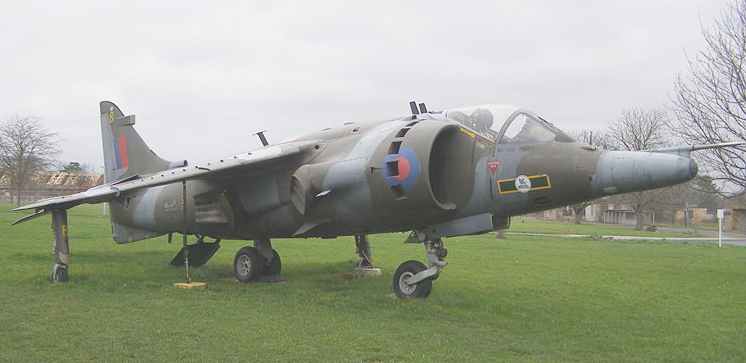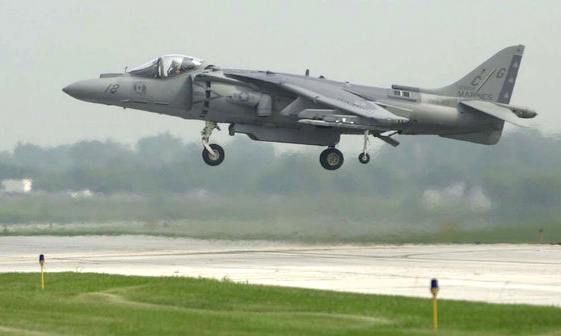|
HAWKER HARRIER
|
|
HOME | BIOLOGY | FILMS | GEOGRAPHY | HISTORY | INDEX | INVESTORS | MUSIC | SOLAR BOATS | SPORT |
|
The Hawker Siddeley Harrier GR.1/GR.3 and the AV-8A Harrier are the first generation of the Harrier series, the first operational close-support and reconnaissance fighter aircraft with V/STOL capabilities. The Harrier was the only truly successful V/STOL design of the many that arose from the 1960s, and the only truly successful V/STOL design period until the development of the F-35 Lightning II in the early 2000s.
The Harrier was extensively redeveloped, leading to the BAE Harrier II and AV-8B Harrier II, that were built by British Aerospace/BAE Systems and McDonnell Douglas.
Background
The Hawker P.1127 and the Hawker Siddeley Kestrel FGA.1 were the development aircraft that led to the Hawker Siddeley Harrier.
P.1127
The Harrier family was started with the Hawker P.1127. Design began in 1957 by Sir Sydney Camm, Ralph Hooper of Hawker Aviation and Stanley Hooker (later Sir Stanley) of the Bristol Engine Company. Rather than using rotors or a direct jet thrust the P.1127 had an innovative vectored thrust turbofan engine and the first vertical take-off was on October 21, 1960. Six prototypes were built in total, one of which was lost at an air display.
Kestrel FGA.1
The immediate development of the P.1127 was into the Hawker Siddeley Kestrel FGA.1, which appeared after Hawker Siddeley Aviation had been created. The Kestrel was strictly an evaluation aircraft, and only nine were produced, the first flying on March 7, 1964.
These equipped the Tripartite Evaluation Squadron formed at RAF West Raynham in Norfolk of 10 pilots from the RAF, USA and West Germany. One aircraft was lost but the remainder transferred to the US for evaluation by the Army, Air Force and Navy, under the designation XV-6A Kestrel.
An order for 60 production aircraft was received from the RAF in 1966, and the first pre-production Harriers, then known as the P.1127(RAF) were flying by mid-1967.
P.1127(RAF)At the time of the development of the P.1127, Hawker had started on a design for a supersonic version, the Hawker P.1154. After this was cancelled in 1965, the RAF began looking at a simple upgrade of the Kestrel as the P.1127(RAF).
In mid-1966, the P.1127(RAF) was ordered by the RAF as the Harrier GR.1, with the first preproduction aircraft flying the following year.
Hovering US Marine Corp AV-8A Harrier, thrust nozzle seen directed along the normal axis
Variants
Harrier GR.1
The Hawker Siddeley Harrier GR.1 was the first production model derived from the Kestrel, it first flew on December 28, 1967, and entered service with the RAF on April 1, 1969. Construction took place at factories in Kingston upon Thames in southwest London and at Dunsfold, Surrey. The latter adjoined an airfield used for flight testing; both factories have since closed.
The ski-jump technique for STOVL use by Harriers launched from Royal Navy aircraft carriers was tested at the Royal Navy's airfield at RNAS Yeovilton (HMS Heron), Somerset. Their flight decks were designed with an upward curve to the bow following the successful conclusion of those tests.
The air combat technique of vectoring in forward flight, or viffing, was developed by the USMC in the Harrier to outmaneuver a hostile aircraft or other inbound weapons.
Harrier GR.1A
The GR.1A was an upgraded version of the GR.1, the main difference being the uprated Pegasus Mk 102 engine. Fifty-eight GR.1As entered RAF service, 17 GR.1As were produced and a further 41 GR.1s were upgraded.
Harrier GR.3
The Harrier GR.3 featured improved sensors (such as a laser tracker in the lengthened nose), countermeasures and a further upgraded Pegasus Mk 103 and was to be the ultimate development of the 1st generation Harrier. This model saw extended service in the Falklands War. (See Service History below)
The RAF ordered 118 of the GR.1/GR.3 series Harrier.
Harrier T.2
Two-seat training version for the RAF.
Harrier T.2A
The Harrier T.2A was an upgraded version of the T.2. The T.2A was powered by a Rolls-Royce Pegasus Mk 102 turbofan engine.
Harrier T4
Two-seat training version for the Royal Air Force.
Harrier T4N
Two-seat training version for the Royal Navy.
Harrier Mk 52
Two-seat company demonstrator. One aircraft only.
AV-8A Harrier
Single-seat ground-attack, close air support, reconnaissance fighter aircraft. The AV-8As of the US Marine Corps were very similar to the early GR.1 version, but with the engine of the GR.3. 113 aircraft were ordered for the US Marines and the Spanish Navy. The AV-8A was armed with two 30-mm ADEN cannon pods under the fuselage, and two AIM-9 Sidewinder air-to-air missiles. The aircraft was powered by a 21,500-lb thrust Roll-Royce Pegasus Mk 103 turbofan engine. It was also a very manoeuverable and a potent air-to-air fighter, being able to outmanoeuvre any other fighter aircraft. Company designation was the Harrier Mk 50.
AV-8C
Upgraded AV-8A aircraft for the US Marine Corps.
AV-8S Matador
Export version of the AV-8A Harrier for the Spanish Navy. Later sold to the Royal Thai Navy. Spanish Navy designation VA-1 Matador. Company designation Harrier Mk 53 for the first production batch, and Harrier Mk 55 for the second batch.
TAV-8A Harrier
Two-seater training version for the US Marine Corps. The TAV-8A Harrier was powered by a 21,500-lb Rolls-Royce Pegasus Mk 103 turbofan engine. Company designation Harrier Mk 54.
TAV-8S Matador
Export version of the TAV-8A Harrier for the Spanish Navy. Later sold to the Royal Thai Navy. Spanish Navy designation VAE-1 Matador. Company designation Harrier Mk 54.
Controls and handling
Operational history
The major combat experience for the Harrier in British service was during the Falklands War where both the Sea Harrier and Harrier GR.3 were used. The Sea Harrier, based on the GR3, was important to the naval activities. Twenty Sea Harriers were operated from the carriers HMS Hermes and Invincible mainly for fleet air defence. Although they destroyed 21 Argentine aircraft in air combat (in part due to using the American-supplied latest variant of the Sidewinder missile and the Argentine aircraft operating at extreme range) they couldn't establish complete air superiority and prevent Argentine attacks during day or night nor stop the daily flights of C-130 Hercules transports to the islands. Two Sea Harriers were lost to ground fire and another four due to operational accidents, none to enemy aircraft. The Harrier GR.3 was operated by the RAF from Hermes and provided close support to the ground forces and attacked Argentine positions but were unable to destroy the Port Stanley runway. If the Sea Harriers had been lost they would have replaced them in air patrol duties.
The RAF Harriers would not see further combat, the Hawker Siddeley airframes would be replaced by the larger Harrier II developed by McDonnell Douglas.
AVIATION A - Z
A taste for adventure capitalists
Solar Cola - a healthier alternative
|
|
This
website
is Copyright © 1999 & 2007 NJK. The bird |
|
AUTOMOTIVE | BLUEBIRD | ELECTRIC CARS | ELECTRIC CYCLES | SOLAR CARS |

